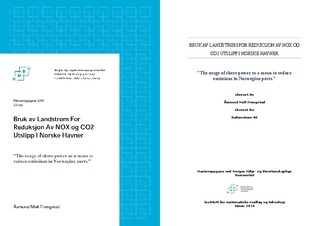| dc.description.abstract | Bruk av Smart Grid og landstrøm for reduksjon av NOX- og CO2- utslipp i norske havner.
I dag slippes det ut mye avgasser fra marine næringer i havner. Disse gassene bidrar både til internasjonale miljøutslipp i form av CO2, men også til lokal luftforurensing. Dette kan føre til redusert livskvalitet for befolkningen og besøkende til havnebyene. For å belyse problemet er Hurtigruten ASA benyttet som eksempel med de havnene den besøker på sin rute opp langs norskekysten.
Rapporten gir en konseptuell anbefaling av konkrete tiltak for rask implementering av landstrøm i havner, der det er teknologisk mulig og økonomisk gjennomførbart. Konseptutviklingen vektlegger en bærekraftig økonomisk modell med målbare miljømessige gevinster i tiltaksområdene.
Denne rapporten beskriver energisystem ombord i skip og på land, samtidig som den gir en oversikt over tilgjengelige teknologier. Konseptutviklingen omhandler systemanalyse, SWOT-analyse, usikkerhetsanalyse, samt strategiske rammebetingelser og strategianalyse. Konseptvurderingen gjøres ved en flermålsanalyse i henhold til Concept nr. 18 {NTNU, 2007 #53} .
High Voltage Shore Connection (HVSC), Cold Ironing og Alternativ Maritim Power (AMP) er forskjellige navn på teknologier for å overføre høyspent elektrisk effekt fra land til skip. Det er en teknisk løsning som gir elektrisk kraft til et skip ved kai, mens skipets hoved- og hjelpemotorer er slått av. HVSC tillater nok elektrisk kraft til teknisk utstyr på båten mens skipet laster eller losser. HVSC er ikke vanlig i dag siden det innebærer å slå av alle skipets interne strømkilder når det er i havn. I den senere tid har flere moderne skip tatt i bruk HVSC teknologi.
Rapporten anbefaler å innføre HVSC-anlegg i Norge. For skip som trafikkerer norskekysten er det et stort innsparingspotensial for energikostnader i havn. For samfunnet vil en investering i HVSC-teknologi i havnen bare ha nytte hvis skipene som ligger til havn benytter seg av den. Anbefalingen blir å gå for en delvis utbygging, der man fokuserer på rute- og cruisetrafikken i første omgang. Sekundært skal supply-havnene til offshoreindustrien velges. Det anbefales at havnene tar investeringen for HVSC-anlegget på land, mens rederiene dekker skipskostnadene. Deler av differansen i pris på energien bør gå til utvidelse av tilbudet. En HVSC-infrastruktur i norske havner bør legges inn i neste NTP periode og bør gis høy prioritet.
Use of SmartGrid and shore power for the reduction of NOX and CO2 emissions in Norwegian ports.
Today, a lot of gases pollute from marine industries in ports. These gases contribute both to international environmental emissions in terms of CO2, but also to local air pollution which may lead to reduced quality of life for people and visitors to the ports. To illustrate the problem, Hurtigruten ASA is used as an example of the ports it visits on its route along the Norwegian coast.
This report provides a conceptual recommendation of specific measures for rapid implementation of shore power in ports, where it is technologically possible and economically feasible. Concept development emphasises sustainable economic model with measurable environmental benefits in the areas of interventions.
This report describes energy systems on board ships and on land, while providing an overview of available technologies. Parts describe Concept development, which deals with systems analysis, SWOT analysis, uncertainty analysis, and strategic framework and strategy analysis. Part for Concept evaluation shows how to use a multiple target analysis to solve the problem.
High Voltage Shore Connection (HVSC), Cold Ironing and Alternative Maritime Power (AMP) are different names for the technology to transmit high-voltage electric power from shore to ship. It is a technical solution that provides electrical power to a ship docked, while the ship's main and auxiliary engines are turned off, HVSC allow enough electrical power to the equipment on the ship while the ship loads or unloads. HVSC is not common today since it involves turning off all the ship's internal power source when it is in port. In recent times more modern ships adopted HVSC technology.
This report recommends introducing HVSC plant in Norway. For ships that sails along the Norwegian coast there is a large potential of saving energy costs in ports. For the society, an investment in HVSC technology in seaports only benefit if the ships use that service in ports. The recommendation will be to go for a partial development, where the focus is on the route and cruise traffic in the first place. Secondly, the supply ports for the offshore industry selected. This report recommends that seaports should bear the investment for HVSC plant on shore, while shipping companies cover the costs in the ships. Part of the difference in price of energy should go to the extension of “A national HVSC infrastructure in Norwegian seaports” for the next National Transport Plan (NTP) period and thus give national HVSC infrastructure a high priority. | nb_NO |
